List of lakes of Tanzania
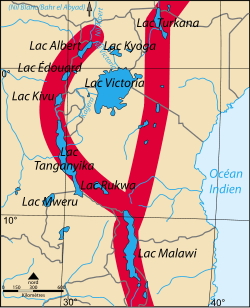
Major lakes along the Great Rift Valley
Tanzania lies in the African Great Lakes region and boasts over 61,500 km2 (23,700 sq mi) of surface area that is covered by lakes. This makes up 6% of the national surface area and 88% of this area is covered by the three major lakes. Lake Victoria and Lake Tanganyika are part of the two great lakes in that nation, with Lake Victoria being the largest freshwater lake in Africa and Lake Tanganyika being the second-deepest lake in the world.[1]
List of lakes
The table lists information about each lake:
- Name: as listed by the World Heritage Committee
- Surface Area: Surface area of lake (note: several lakes change their surface area continually based on weather)
- Bordering Nations: Nations whose border goes through the lake
- Description: Brief description of the lake
-
 Disputed Lake"
Disputed Lake"
| Name | Image | Surface Area | Bordering Nations | Notes | Reference |
|---|---|---|---|---|---|
| Lake Victoria | 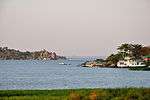 |
68,800 km2 (26,600 sq mi) | Lake Victoria is the largest of the African Great Lakes and is the largest freshwater lake in the world. The Lake is also the second-largest freshwater lake in the world and spans across three countries. The lake is the solely drained by the Nile river at Jinja. | [2] | |
| Lake Tanganyika |  |
32,900 km2 (12,700 sq mi) | Lake Tanganyika is an African Great Lake and is the second-deepest lake in the world and the second-biggest lake by volume. The lake borders four nations and is vital for trade and commerce for societies living along the lake. The lake is home to the oldest-running ferry in the world, MV Liemba. | [3] | |
| Lake Nyasa |  |
29,600 km2 (11,400 sq mi) | Tanzania has over 800 kilometres (500 mi) of coastline with the lake; however, the border with Malawi is disputed and currently the lake is not entirely part of Tanzania. The lake is also known as Lake Malawi. | [4][5] | |
| Lake Rukwa |  |
~ 5,760 km2 (2,220 sq mi) | Lake Rukwa is an Endorheic lake in the Rukwa Valley in southwest Tanzania. The lake is an alkaline lake and lies at about 800 metres (2,600 ft) of altitude along the Great Rift Valley system. | [6] | |
| Lake Eyasi | 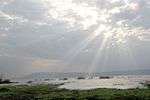 |
1,050 km2 (410 sq mi) | Lake Eyasi is an endorheic salt lake on the floor of the Great Rift Valley. The lake has dramatic seasonal fluctuations in water and almost dries up in the dry season. | ||
| Lake Natron | 1,040 km2 (400 sq mi) | Lake Natron is a salt and soda lake. The lake is in the Arusha region near the famous Ol Doinyo Lengai. The lake is famous for its red alkaline layer and its pH fluctuates between 10.5 and 12. | [7] | ||
| Lake Manyara | 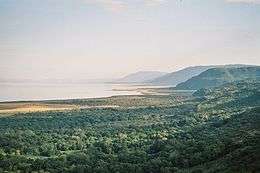 |
230.5 km2 (89.0 sq mi) | Lake Manyara is shallow alkaline lake in the East African Rift and is surrounded by the 127-square-mile (330 km2) Lake Manyara National Park. | ||
| Lake Burigi | 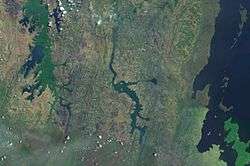 |
70 km2 (27 sq mi) | The lake is located in the Kagera Region of Northern Tanzania. The lake spans 18 kilometres (11 mi) long and it is so narrow that the other side is always visible from one side. Part of the lake is located along the Burigi Game Reserve and has several wildlife living around the lake. | [8] | |
| Lake Balangida | 33 km2 (13 sq mi) | Lake Balangida is an alkaline lake in the Natron-Manyara-Balangida branch of the East African Rift in north-central Tanzania. | [9] | ||
| Lake Jipe |  |
30 km2 (12 sq mi) | Lake Jipe is in the Mwanga District in the Kilimanjaro Region on the border with Kenya. The lake is mainly in Kenya and is protected on the Kenyan side by the Tsavo West National Park and on the Tanzanian side it is in close proximity to Mkomazi National Park. | ||
| Lake Babati |  |
21 km2 (8.1 sq mi) | Lake Babati is located in Babati District in Arusha Region to the west of the Tarangire National Park. The lake is known for its large hippo population. | ||
| Lake Ambussel | 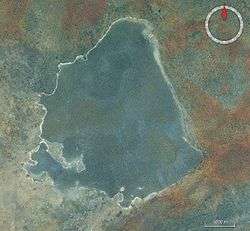 |
19 km2 (7.3 sq mi) | Lake Ambussel is one of the four water bodies in the Pangani Basin. | [10] | |
| Lake Chala |  |
4.2 km2 (1.6 sq mi) | Lake Chala is a crater lake at the edge of Mount Kilimanjaro. The lake is surrounded by a 100-kilometre (62 mi) crater rim and is home to the endangered Lake Chala tilapia. The lake once had Nile crocodiles; however, they were considered a nuisance to the local population and have been entirely wiped out over the years. | [11] |
See also
References
- ↑ "Source book for the inland fishery resources of Africa Vol. 1". www.fao.org. Retrieved 2016-01-05.
- ↑ "Lake Victoria | lake, Africa". Encyclopedia Britannica. Retrieved 2016-01-05.
- ↑ "LakeNet - Lake Tanganyika". www.worldlakes.org. Retrieved 2016-01-05.
- ↑ "Lake Nyasa Facts, information, pictures | Encyclopedia.com articles about Lake Nyasa". www.encyclopedia.com. Retrieved 2016-01-05.
- ↑ "LakeNet - Lake Malawi". www.worldlakes.org. Retrieved 2016-01-05.
- ↑ Ricardo, C. K. (1939-12-01). "The fishes of Lake Rukwa.". Journal of the Linnean Society of London, Zoology. 40 (275): 625–657. doi:10.1111/j.1096-3642.1939.tb01695.x. ISSN 1096-3642.
- ↑ "Lake That Turns Animals to Stone? Not Quite : DNews". DNews. Retrieved 2016-01-05.
- ↑ Bossche, J.-P. vanden; Bernacsek, G. M.; Nations, Food and Agriculture Organization of the United (1990-01-01). Source Book for the Inland Fishery Resources of Africa. Food & Agriculture Org. ISBN 9789251029831.
- ↑ "Source book for the inland fisheries of Africa vol. 1". FAO.
- ↑ Bossche, J.-P. vanden; Bernacsek, G. M.; Nations, Food and Agriculture Organization of the United (1990-01-01). Source Book for the Inland Fishery Resources of Africa. Food & Agriculture Org. ISBN 9789251029831.
- ↑ "Lake Chala, Moshi, Tanzania. The Lake Chala Safari Camp". www.lakechalasafaricamp.com. Retrieved 2016-01-05.
External links
This article is issued from Wikipedia - version of the 12/3/2016. The text is available under the Creative Commons Attribution/Share Alike but additional terms may apply for the media files.
